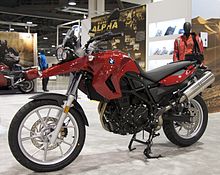BMW F series parallel-twin
 | |
| Manufacturer | BMW Motorrad |
|---|---|
| Production | since 2008 |
| Predecessor | F650GS (single-cylinder) |
| Class | Dual-sport |
| Engine | 798 cc, parallel-twin, Water Cooled, Four-Stroke, DOHC, 8-valves |
| Power | F800: 85 hp (63 kW) @ 7,500 rpm F650: 71 hp (53 kW) @ 7,000 rpm |
| Torque | F800: 83 N⋅m (61 lb⋅ft) @ 5,750 rpm F650: 75 N⋅m (55 lb⋅ft) @ 4,500 rpm |
| Transmission | 6-speed, O-Ring chain |
| Suspension | F800: Telescopic fork 45 mm F650:Telescopic fork 41 mm |
| Brakes | F800 Front: Twin 300 mm discs, 2 piston calliper; Rear: 265 mm disc, 1 piston calliper; ABS optional F650 Front: Single 300 mm disc, 2 piston calliper; Rear: 265 mm disc, 1 piston calliper; ABS optional |
| Tires | F800: Spoked wheels with 90/90 21 front tyre and 150/70 17 rear tyre F650: Aluminium alloy wheels with 110/80 19 front tyre and 140/80 17 rear tyre |
| Wheelbase | F800: 1,578 mm (62.1 in) F650: 1,575 mm (62.0 in) |
| Dimensions | L: F800: 2,320 mm (91 in) F650: 2,280 mm (90 in) W: F800: 945 mm (37.2 in) including mirrors F650: 890 mm (35 in) including mirrors H: F800: 1,350 mm (53 in) excluding mirrors F650: 1,240 mm (49 in) excluding mirrors |
| Seat height | F800: 880 mm (35 in) F650: 820 mm (32 in) |
| Weight | F800: 185 kg (408 lb) F650: 179 kg (395 lb) (dry) F800: 207 kg (456 lb) F650: 199 kg (439 lb) (wet) |
| Fuel capacity | 16 litres (976.4 cu in) |
| Related | F800S, F800ST, F800R |
The BMW F800GS and F650GS are members of the GS family of dual-sport motorcycles manufactured in Berlin, Germany by BMW Motorrad. Both bikes were launched in 2008, and use the same 798 cc parallel-twin engine with chain drive, but with different power outputs and equipment levels. The F650GS name can cause confusion as it was also used for a 652 cc BMW bike fitted with a single-cylinder Rotax engine, produced from 2000 to 2007; a bike which has now been relaunched as the G650GS fitted with a Chinese-manufactured engine of the same 652 cc capacity. The parallel-twin engine was first used in the F800S,[1] and is also used in the F800ST and F800R, although these bikes are tuned to deliver peak power at a different RPM from the GS models. On the GS models the engine is angled further backwards to provide longer suspension travel, needed for offroad use.[2] The 800Gs was used by the Morgans for part of their round the world epic in 2009.(see Discussion)

Model differences
Although both bikes use the same basic engine, there are a number of differences.[2] The F800 produces 85 hp (63 kW), which is 14 hp (10 kW) more power than the F650. The F650 engine can be modified to deliver a reduced power output of 25 kW (34 hp) for European riders on restricted Category A licences.[3][4] The F800 is fitted with twin brake discs on the front while the F650 is fitted with just one disc.[2] Both bikes feature optional anti-lock brakes (ABS). The F800 features spoked wheels with a 21 inch front and 17 rear, while the F650 has cast aluminium alloy wheels with a 19 inch front and 17 rear. The standard seat height on the F800 is 880 mm (35 in), compared with 820 mm (32 in) for the F650, which can be further reduced with a low seat and lowered suspension to 765 mm (30.1 in) making it suitable for much shorter riders.
References
- ^ Ash, Kevin (6 March 2008). "BMW F800GS: Fixing a hole". Daily Telegraph. Retrieved 26 January 2009.
- ^ a b c Omorogbe, Jane (3 April 2008). "Ridden: BMW F800GS and F650GS". MSN. Retrieved 26 January 2009.
- ^ "Full Driving Licence for Motorcycles". Meath County Council. Retrieved 26 January 2009.
- ^ "Routes to your motorcycle licence" (PDF). UK Department for Transport. Retrieved 21 January 2011.
External links
- Official BMW site for F800GS
- Official BMW site for F650GS
- F800GS review by Motorcycle News
- F650GS review by Motorcycle News
